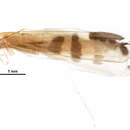Comprehensive Description
provided by Smithsonian Contributions to Zoology
Nectopsyche argentata
This species belongs to the gemma group, and is closest to N. gemma (Müller) itself. In coloration these species are virtually indistinguishable, but N. gemma tends to have several longitudinal bands of white hair in cells between the eye–spots and the anterior margin of the forewing. In the male genitalia, the phallus lacks the periphallic processes in N. gemma that are clearly present, although small, in N. argentata. The basoventral processes of the clasper are generally digitate in N. argentata, but much broader, sometimes being as broad as long, in N. gemma; however, they are occasionally of the same size in the two species. I place two females from Mexico in N. argentata, which they match perfectly in maculation. Unfortunately, we have no males from Mexico which would substantiate this placement, although the presence of the species in Costa Rica is supportive.
ADULT.—Length of forewing, male 7–8 mm, female 6–7 mm. Color golden yellow marked with silver, white and black; head mostly golden with white hair around eyes, mesally on vertex and dorsally on antennae; thorax mostly golden with 2 longitudinal white lines on each side of mesonotum; forewing golden yellow marked with silver iridescent lines, and 4 black ocellate spots on posteroapical margin which are banded inwardly by white scales. Eyes of male small, in ventral aspect slightly less than half as wide as interocular distance. Male genitalia: Ninth segment with a small dorsomesal lobe; dorsomesal arms deeply forked apicad. Tenth tergite elongate, tip obliquely truncate. Clasper with ventral margin angulate, tip with a spatulate apicomesal lobe; basoventral process elongate, terite, with a few setae (rarely up to twice as wide as shown, then with several more setae). Phallus with periphallic processes small, not greatly modified apically; with ventral plate, internal sclerite, and a band of small spines.
MATERIAL.—Holotype, male: COLOMBIA. DPTO. ANTIOQUIA: Quebrada Honda, Marsella [12 km SW Fredonia], 1450 m, 3–4 Mar 1984, C.M. & O.S. Flint, Jr. USNM Type.
Paratypes: Same data as holotype, 2. Quebrada La Mosca, 2 km W Guarne, 7 Feb 1983, O.S. Flint, Jr., 1. VENEZUELA. EDO. ZULIA: El Tucuco [45 km SW Muchiques], 5–6 Jun 1976, Menke and Vincent, 1, 1. EDO. BARINAS: Barinitas, 22–26 Feb 1969, Spangler, Duckworth, and Dietz, 2; same, but 15 km SW Barinitas, 25 Feb 1969, 1. Río Sto. Domingo, Barinas, 17 Feb 1976, C.M. & O.S. Flint, Jr., 5. COSTA RICA. PCIA. GUANACASTE: Parque Nacional Guanacaste, Maritza, Río Tempisquito, 10.958°N, 85.497°W, 550 m, 17–18 Jun 1988, C.M. & O.S. Flint, Jr., and Holzenthal, 11; same, but Est. Mengo, Río San Josecito, 10.922°N, 85.470°W, 960 m, 28–29 Jul 1987, Holzenthal, Morse, and Clausen, 6. Parque Nacional Rincón de la Vieja, Río Negro, 10.765°N, 85.313°W, 810 m, 3 Mar 1986, Holzenthal and Fasth, 2, 1. PCIA. PUNTARENAS: Río Bellavista, ~1.5 km NW Las Alturas, 8.951°N, 82.846°W, 1400 m, 8–9 Apr 1987, Holzenthal, Hamilton, and Heyne, 6; same, but 2–3 Aug 1987, Holzenthal, Morse, and Clausen, 2; same, but 18 Feb 1986, Holzenthal, Morse, and Fasth, 5. Río Cotón in Las Alturas, 8.938°N, 82.826°W, 1360 m, 16 Feb 1986, Holzenthal, Morse, and Fasth, 2. PCIA. ALAJUELA: Cerro Campana, Río Bochinche, tributary, 6 km (air) NW Dos Ríos, 10.645°N, 85.413°W, 600 m, 15–16 Mar 1986, Holzenthal and Fasth, 1; same, but 22–23 July 1987, Holzenthal, Morse, and Clausen, 1.
OTHER.—MEXICO. EDO. VERACRUZ: near Huatusco, 25–26 Jul 1965, Flint and Ortiz, 2.
- bibliographic citation
- Flint, Oliver S., Jr. 1991. "Studies of Neotropical Caddisflies, XLV: The Taxonomy, Phenology, and Faunistics of the Trichoptera of Antioquia, Colombia." Smithsonian Contributions to Zoology. 1-113. https://doi.org/10.5479/si.00810282.520

